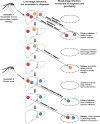Malaria Epidemiology at the Clone Level
- PMID: 28966050
- PMCID: PMC5777529
- DOI: 10.1016/j.pt.2017.08.013
Malaria Epidemiology at the Clone Level
Abstract
Genotyping to distinguish between parasite clones is nowadays a standard in many molecular epidemiological studies of malaria. It has become crucial in drug trials and to follow individual clones in epidemiological studies, and to understand how drug resistance emerges and spreads. Here, we review the applications of the increasingly available genotyping tools and whole-genome sequencing data, and argue for a better integration of population genetics findings into malaria-control strategies.
Keywords: SNP; drug resistance; microsatellite; parasite migration; relapse; whole-genome sequencing.
Copyright © 2017 Elsevier Ltd. All rights reserved.
Figures


References
-
- Anderson TJ, et al. Microsatellite markers reveal a spectrum of population structures in the malaria parasite Plasmodium falciparum. Mol Biol Evol. 2000;17(10):1467–82. - PubMed
Publication types
MeSH terms
Grants and funding
LinkOut - more resources
Full Text Sources
Other Literature Sources
Medical

